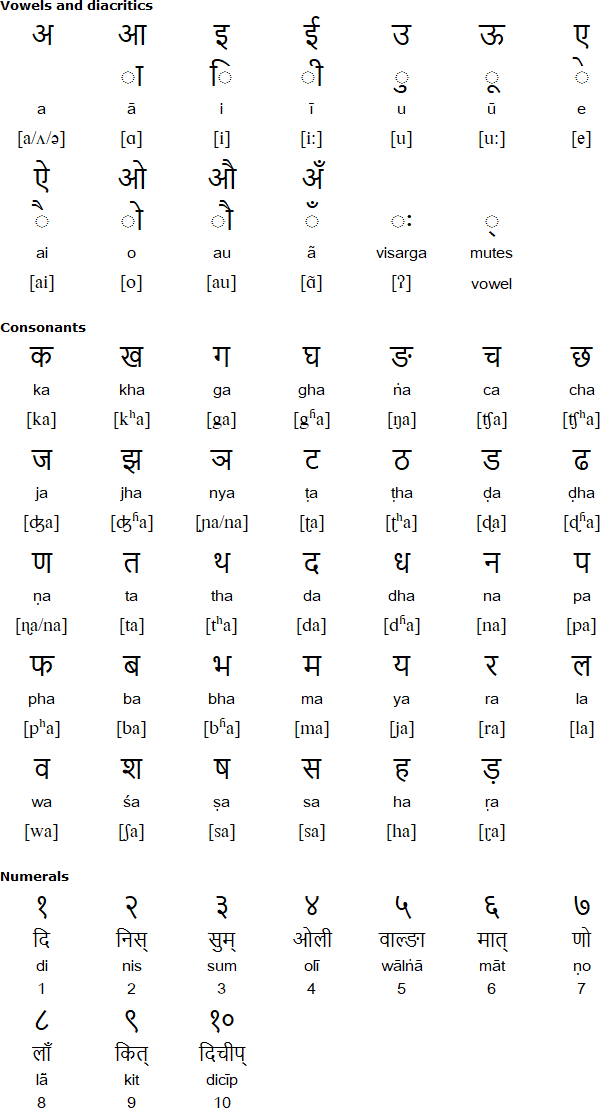Thangmi is a member of the Newari branch of the Sino-Tibetan language family. It is spoken 23,580 people in eastern Nepal, mainly in the Dolakha District of Bagmati Province, and also in the neighbouring Sindhupalchok district. In addition, there are about 500 speakers of Thangmi in northern India, mainly in Darjeeling in West Bengal, and in the East district of Sikkim, and another 300 in Tibet in western China.
Thangmi is also known as Thāmī, Thangmi Kham, Thangmi Wakhe or Thani. There are two main dialects: Eastern Thangmi (Dolakha) and Western Thangmi (Sindhupalchok). They are not mutually intelligible, and the Eastern dialect has the most speakers.
Thangmi is spoken mainly by adults. Children tend to speak Nepali, although they may understand Thangmi and are taught in primary schools. It is used to a limited extent in literature and the media, and is written with the Devanagari alphabet.

Download an alphabet chart for Thangmi (Excel)
साक्खा मि प्रतिष्ठा ङा हिक्काको आधारङा नि वित्तिकाई स्वतन्त्र ङा थादु। तोबाङ बुद्धि ङा विवेक नामा केल्योङ्दु थादु ङा दि बेगाले नामा हु हु को व्यवहार नोङ्को माईदु।
Sākkhā mi pratiṣthā ṅā hikkāko ādhārṅā ni wittikāī swatantra ṅā thādu. Tobāṅ buddhi ṅā wiwek nāmā kelyoṅdu thādu ṅā di begāle nāmā hu hu ko wyawhār noṅko māīdu.
All human beings are born free and equal in dignity and rights. They are endowed with reason and conscience and should act towards one another in a spirit of brotherhood.
(Article 1 of the Universal Declaration of Human Rights)
Details provided by Biswajit Mandal (biswajitmandal[dot]bm90[at]gmail[dot]com)
Information about Thangmi
https://en.wikipedia.org/wiki/Thangmi_language
https://www.ethnologue.com/language/thf
http://www.endangeredlanguages.com/lang/4838
http://www.endangeredlanguages.com/lang/4838
A Grammar of the Thangmi Language: with an Ethnolinguistic Introduction to the Speakers and Their Culture
https://www.notesnepal.com/archives/8166
Angami, Bai, Darmiya, Galo, Miju, Rawang, Tangut, Thangmi, Tujia
Aka-Jeru, Angika, Athpare, Avestan, Awadhi, Bahing, Balti, Bantawa, Belhare, Bhili, Bhumij, Bilaspuri, Bodo, Bhojpuri, Braj, Car, Chamling, Chhantyal, Chhattisgarhi, Chambeali, Danwar, Dhatki, Dhimal, Dhundari, Digaro Mishmi, Dogri, Doteli, Gaddi, Garhwali, Gondi, Gurung, Halbi, Haryanvi, Hill Miri, Hindi, Ho, Jarawa, Jaunsari, Jirel, Jumli, Kagate, Kannauji, Kham, Kangri, Kashmiri, Khaling, Khandeshi, Kharia, Khortha, Korku, Konkani, Kullui, Kumaoni, Kurmali, Kurukh, Kusunda, Lambadi, Limbu, Lhomi, Lhowa, Magahi, Magar, Mahasu Pahari, Maithili, Maldivian, Malto, Mandeali, Marathi, Marwari, Mewari, Mundari, Nancowry. Newar, Nepali, Nimadi, Nishi, Onge, Pahari, Pali, Pangwali, Rajasthani, Rajbanshi, Rangpuri, Sadri, Sanskrit, Santali, Saraiki, Sirmauri, Sherpa, Shina, Sindhi, Sunwar, Sylheti, Tamang, Thakali, Thangmi, Wambule, Wancho, Yakkha, Yolmo
Page last modified: 23.04.21
[top]
You can support this site by Buying Me A Coffee, and if you like what you see on this page, you can use the buttons below to share it with people you know.

If you like this site and find it useful, you can support it by making a donation via PayPal or Patreon, or by contributing in other ways. Omniglot is how I make my living.
Note: all links on this site to Amazon.com, Amazon.co.uk
and Amazon.fr
are affiliate links. This means I earn a commission if you click on any of them and buy something. So by clicking on these links you can help to support this site.
[top]